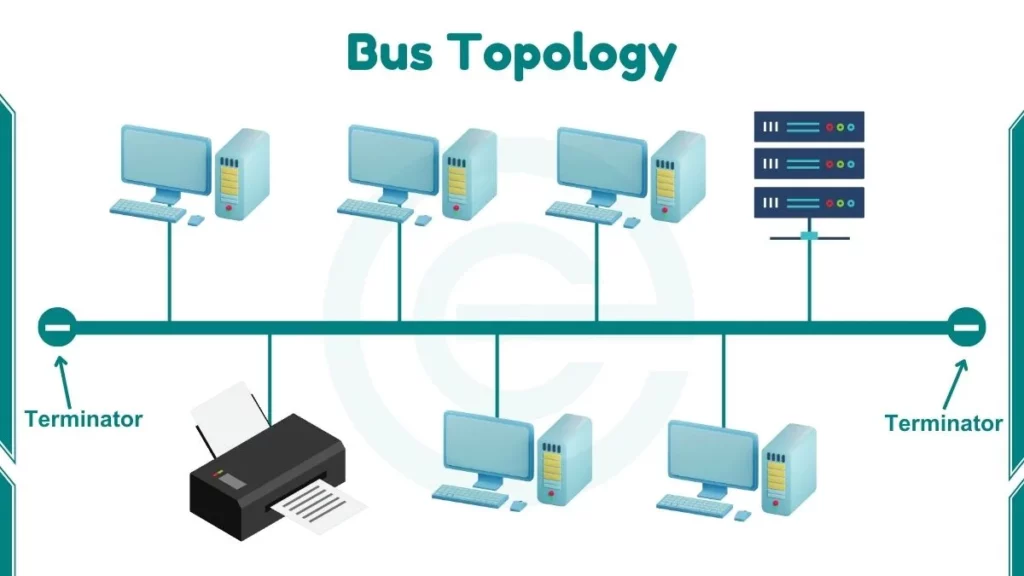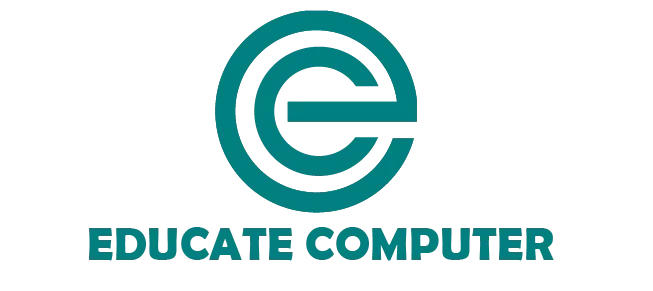Bus topology is a type of network. It supports a small number of computers. All computers or devices are connected to a common communication medium in a bus topology. This medium is called a bus or backbone.
The terminators are used at the end of a bus to absorb the signal and stop them from traveling backward. Collision can occur in bus topology if two computers transmit data at the same time.
Also Read: Advantages and Disadvantages of Bus Topology

Example of Bus Topology
Here are a few examples of bus topology:
1. Computer networks: An everyday use of bus topology is in wired Ethernet networks. All devices such as computers and printers, connect to a single cable. It allows them to communicate with each other.
2. Cable television: Cable TV providers use bus topology to deliver signals to your home. The main cable line acts as the bus, connecting branches to individual houses.
3. Arcade machines: Classic arcade cabinets are sometimes linked using a bus topology. This allows for multiplayer functionality in games where multiple cabinets are needed. The data bus between the linked machines allows them to communicate and coordinate game actions.
4. Christmas lights: A simple string of Christmas lights can be seen as a bus topology. The power cable acts as the bus, with a bulb connected and receiving electricity along the line. If the power cable is damaged all the lights powered through it will stop working.
Characteristics of Bus Topology
Here are the most common bus topology characteristics:
- Single Communication Channel: All devices in a bus network are connected to a common single communication medium that acts as a shared backbone for the transmission of data between devices. This backbone is normally a single cable or a set of cables that devices tap into.
- Shared Medium: Since all devices in a bus network share access to the common communication medium. The available bandwidth gets shared among all the connected devices. This can become a limiting factor and performance bottleneck in bus networks with high traffic volumes from many devices.
- Broadcast Communication: When any device transmits data onto the bus, the data is broadcasted and propagated along the whole length of the medium to reach all devices connected to it. Each device checks the destination address of the data packet to determine if they are the intended recipient.
- Half-Duplex Operation: The bus topology normally allows data flow in only one direction at a time along the shared backbone. So devices generally cannot transmit and receive data simultaneously. This half-duplex operation prevents collisions.
- Terminators: To stop the signal from being reflected when it reaches the end of the bus medium. Terminators that match the impedance of the cable are connected at both ends. Reflection can corrupt data.
- Limited Scalability: Expanding a bus networked system by adding more devices has practical limits because the shared medium can become saturated. Adding too many devices that communicate heavily can lead to congestion issues which deteriorates overall performance.
How Does Bus Topology Work?
Computers connect to the bus cable using drop lines and tap connectors. This allows a node to tap signals from the bus when required. Nodes can actively put signals onto the bus for other nodes to receive.
Bus networks rely on a multi-drop access method. This allows multiple nodes to share access to the bus cable for communication. Only one node transmits data at a time in a bus topology.
A bus network uses carrier sensing for transmission decisions. A node checks if the bus is idle or busy before transmitting. If busy, the node waits for its turn. This is called CSMA/CD (Carrier Sense Multiple Access with Collision Detection) protocol.
Collision occurs when more than one device transmits simultaneously. CSMA/CD handles this by signaling nodes to stop, wait, and retry later.
The bus cable length limits the number of nodes that can be connected in a single bus network segment. Overall length also affects signal quality and network performance.
If you want to see how Bus Topology differs from Star Topology, read detailed comparison on Differences Between Bus and Star Topology.
Topic Quiz
1. In a bus topology, all devices are connected to a single:
- (A) Hub
- (B) Switch
- (C) Router
- (D) Backbone Cable (Correct)
2. What components absorb signals at the end of a bus cable to prevent reflection?
- (A) Hubs
- (B) Switches
- (C) Terminators (Correct)
- (D) Routers
3. Bus topology is best suited for networks with:
- (A) High traffic
- (B) Many devices
- (C) Low traffic and few devices (Correct)
- (D) Large geographical areas
4. An example of a device that might use bus topology is:
- (A) Internet backbone
- (B) Wired Ethernet network (Correct)
- (C) Cellular network
- (D) Wide Area Network (WAN)
5. In a bus network, if one device malfunctions, it can affect:
- (A) Only the intended recipient
- (B) Only devices connected directly
- (C) The entire network (Correct)
- (D) No other devices
